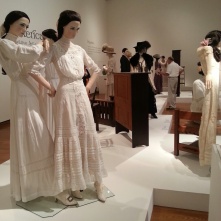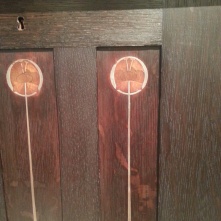Nature of the Gothic and The Two Paths: Modern Manufacture and Design
Reading Ruskin, if I mapped my reactions, would look like a sine graph, or maybe a seismograph during tectonic disturbances. At times, I found myself understanding what he was working on – creating a way to talk about art by emphasizing design. Situated in time, Ruskin is witnessing the industrialization of Britain, or the loss of nature: a void of art, and the dissipation of periods of “art” as over the top ornate decoration that did not fit purpose or place. Here I pause to wonder if art, as Ruskin is using it, is equal to craft in techne. I think yes/no.
Yes: he is working to give a language to talking about design – being able to know it and understand it in terms of place (where the art is located/situated), material (what can be done with a material to fit the form – but here he seems to focus mostly on human form, which leads me to start to say no, he’s venturing into aesthetic values that shift out of the realm of use…), and office (understanding the position of what one is creating – which I’m equating to balance: some parts of design must be humble so others are prominent).
No: he is romantic of nature and describes art as a condition and creation of the natural (which leads me to say yes because however utopic, he is working toward creating things as living and functioning art in homes, which leads me to think of use and value – made to fit people, as well as a pause in what seemed to be progression toward machination of objects, i.e. not craft)
(Maybe my reading depiction would be a mobius strip…) I try to situate in time why Ruskin’s use of conventional (as opposed to natural) might be negative as equivalent to our standardized. And how his focus on the human figure might be a way of talking about objects that are mindful of the human figure in their design in terms of form and material. But what seems lacking is the workman/craftsman as maker of these objects and the objects he seems to dwell on (painting and sculpture) don’t seem relative to human use or interaction – they seem removed. And then, in mobius fashion, I turn on myself again to say that architecture, in design and decoration, as far as what humans are inhabiting in terms of space/place seems significant to what objects were designed and made in terms of giving rise to them or thwarting them. This makes me think of one of Pye’s critiques of Ruskin:
While Pye acknowledges that life in Ruskin’s time depended on highly regulated workmanship for its continuance with industrialization, he tried to position himself outside of industry, something that wasn’t explicitly addressed in his work, but that had an effect on the position of the worksman within/in relation to industry. Pye summarizes Ruskin’s design/art/workmanship principles as follows (118-19):
1. Men can only take pleasure in their work if they are allowed to invent, to design as well as make (and to do so from nature)
2. Worksmen, by no fault of their own, are untaught and unsophisticated
3. Therefore, their designs will be rough and imperfect
In Pye’s critique, Ruskin isn’t thinking about design from the worksman/craftsman, but as removed prejudices of industrialization not rooted in making. Without this relation to making, and makers, Ruskin seems to be talk about aesthetics in the same hollow way craft can be talked about in contemporary times as nostalgia for the simpler past. Ruskin describes art, this time directed to the workman (or at least gestured), as:
“Beautiful art can only be produced by people who have beautiful things about them, and leisure to look at them; and unless you provide some elements of beauty for your workmen to be surrounded by, you will find that no elements of beauty can be invented by them.”
I can see this moving toward the arts and crafts lifestyle movement, or a return to nature or the countryside away from city factories, convention, and mechanization, but what does this mean to making? What does this mean to the craftsman/worksman? The form and function and decoration of objects? Who got to make art as craft and by what means? (art seems positioned as hobby in Ruskin) Was the arts and crafts movement of the time always positioned as such a binary? (again, I think of the time: industrialization in the process of becoming industrialized.) Also, why Gothic architecture?










